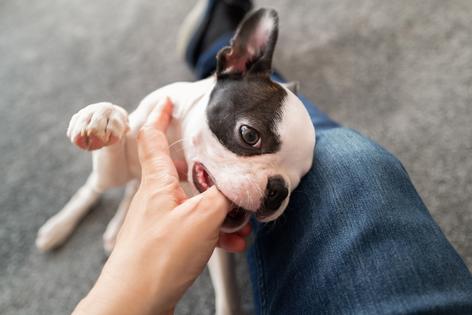My Pet World: Puppy biting driving you nuts? Here's how to nip the nipping
Dear Cathy,
I need help. I have a four-month-old male cocker spaniel who insists on biting and nipping. I’ve tried telling him “no biting” and “leave it.” He went to puppy school where the instructor said to give him toys and hard chews. I have been doing all that since he came home.
He’s sociable with both humans and other dogs. I want him to break this habit before he gets much older. What more can be done?
— Sharon, Northampton, Pennsylvania
Dear Sharon,
At four months old, your cocker spaniel is going through a teething phase and learning how to interact with the world. Nipping is how puppies play with each other and learn bite inhibition. When a nip is too hard, their playmate lets them know. If your puppy didn’t get much of that early feedback from littermates, he may not yet understand what’s acceptable.
You’re already doing many of the right things – offering toys and chews, using redirection, and going to puppy school. But this stage can still be challenging because teething and social development are happening at the same time.
To help, stay consistent with your response. If he nips you, say “ouch” in a calm but firm voice and immediately stop all interaction. Turn away or briefly leave the room. This mimics how another puppy would react and teaches him that biting ends the fun. I know that means stepping away a lot, but it’s worth it if your puppy starts getting the message.
Next, don’t underestimate the power of training – not just obedience like “sit” or “stay,” but also fun, mentally stimulating games like “touch,” “find it,” or simple puzzle toys where your puppy has to figure out how to get the treat. These activities help burn energy, build focus, and provide a healthy outlet for his natural curiosity. They also strengthen your bond and teach him to look to you for direction, which reduces unwanted behaviors overall.
At the same time, keep rotating his toys and chews so he stays interested, and provide frozen teething toys to help soothe sore gums. He is still teething.
You might also want to consider scheduling puppy playdates with calm, well-socialized dogs. A few good play sessions can reinforce appropriate behavior in ways we humans can’t always replicate. If you know someone with a puppy, set up a few playdates. Otherwise, call local doggie daycares or training facilities to see if they offer supervised puppy play sessions. With time, patience, and continued training and positive reinforcement, your puppy will grow out of this phase and into a well-mannered companion.
Dear Cathy,
I adopted a six-year-old female Akita who had two previous owners. It took three years to train her off-leash. I walk her twice a day, feed her, give her treats, and play with her. We've been together almost six years. Despite this, she prefers to lie in my brother's room and seeks him out during storms. His only interaction is sweet talk and petting. I’m hurt and dumbfounded. Why does she prefer him?
— Robert, Virginia Beach, Virginia
Dear Robert,
Dogs, like people, sometimes form unique emotional associations with certain people – or even specific spaces – based on subtle patterns we may not notice. It could be that your brother’s room is quieter, cooler, more soundproof, or simply the place she happened to feel safe during a storm early on.
Dogs can also be drawn to certain scents, and it’s entirely possible there’s something in that room – your brother’s scent, a familiar blanket, or even the smell of the space itself – that she finds soothing or appealing. Over time, that combination of comfort cues may have created a “safe zone” in her mind, and that’s where she instinctively retreats when she’s scared.
If you want to help her associate that same comfort with you, try using canine pheromone sprays on your lap or on furniture in the areas where you relax together. During a mild storm, you might also try calmly sitting with her, providing treats or a favorite toy. Offering gentle reassurance without pressure helps her build a new association with you as her “thunder buddy.”
You may also want to consider incorporating a little extra training into her daily routine. Even brief sessions – five to 10 minutes a day – can deepen your bond and build new layers of trust and connection. Training isn’t just about teaching commands; it’s a form of communication that reinforces your role as a calm, confident leader. Whether you’re practicing basic cues or learning something new and fun, shared training time helps strengthen the emotional bridge between you.
_____
_____
========
(Cathy M. Rosenthal is a longtime animal advocate, author, columnist and pet expert who has more than 25 years in the animal welfare field. Send your pet questions, stories and tips to cathy@petpundit.com. Please include your name, city, and state. You can follow her @cathymrosenthal.)
©2025 Tribune Content Agency, LLC.
(c) 2025 DISTRIBUTED BY TRIBUNE MEDIA SERVICES, INC.












Comments